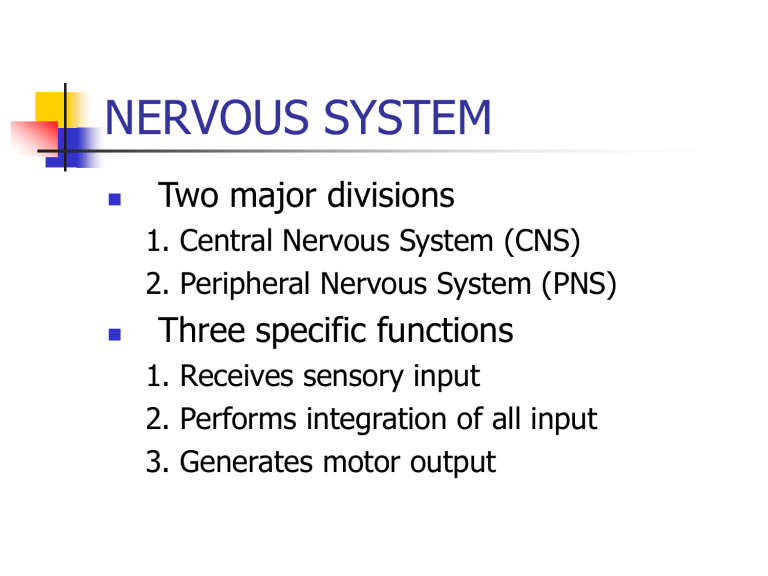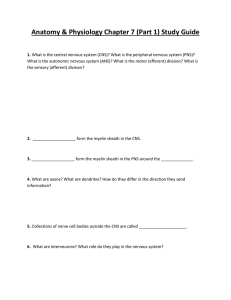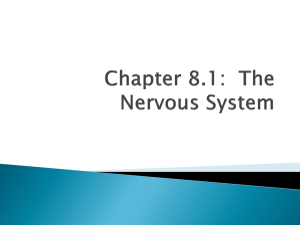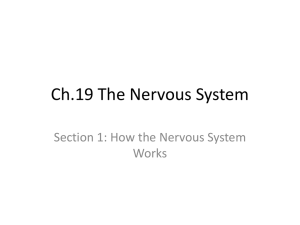nervous system - De Anza College

NERVOUS SYSTEM
Two major divisions
1. Central Nervous System (CNS)
2. Peripheral Nervous System (PNS)
Three specific functions
1. Receives sensory input
2. Performs integration of all input
3. Generates motor output
Nervous Tissue
Contains two types of cells
1. Neuroglial cells(make up more than half the brain)
2. Neurons
Neuroglial cell function
1. Structural and protective
2. Support and nourish neurons
3. Insulation and development guide
(myelin sheath)
Nervous Tissue (cont’)
Neurons
1. Three types of neurons a. Sensory neurons – transmit nerve impulses from stimulus to the CNS b. Interneurons – in central nervous system c. Motor neurons – instructions away from to muscles or glands.
2. Parts of a neuron: dendrites, cell bodynucleus, axon, myelin sheath & nodes of
Ranvier
Myelin Sheath
In the PNS, the neuroglial cells responsible for myelination are called Schwann cells
In the CNS, Schwann cells are absent, therefore myelin is provided by oligodendrocytes
Speeds signal conduction
Made of lipids and phospholipids
Guides nerve regeneration
Attacked by immune system in multiple sclerosis
The Nerve Impulse
All cells have a membrane potential or voltage (electrical charge) across their plasma membrane
At rest, when no nerve impulse is being received, the potential is about - 65mV
1. Potential due to difference in Na + and K + concentration across the axon membrane
2. K + able to cross axon membrane, Na + not
The Nerve Impulse cont’
3. Build up of neg. charge results inside axon and more pos. charge outside, hence membrane potential = -65mv
When the axon receives an impulse, the membrane potential changes
1. When the membrane potential reaches – 40Mv
(threshold level), Na + channels open
2. Influx of Na + causes depolarization of the membrane to occur
3. When the membrane potential reaches +40mV,
K+ channels open – repolarization occurs
4. Inside of axon reverts to pre-dominant neg chg.
The Nerve Impulse cont’
When an impulse has passed a section of an axon, a refractory period begins
(period following an action potential when a neuron can’t conduct another impulse) as the sodium channels are unable to open.
This keeps the impulse running down the axon in the same direction
The Synapse
Synapses separate one neuron form another
Neurons physically do not touch one another
A synapse is a gap that separates neurons
Neurotransmitters released from the terminal bulb enter into the synapse and move across the space
(called the synaptic cleft) by diffusion
Neurotransmitters leave the presynaptic neuron and diffuse toward the postsynaptic neuron, where they settle on receptors and initiate a reaction
Neurotransmitters carry the message across the synapse
Neurotransmitters are chemicals that carry an impulse across the synaptic cleft
The Central Nervous System
The brain has four main parts
Brain stem + midbrain
Diencephalon
Cerebellum
Cerebrum
The entire brain is involved in the integration of sensory input and motor responses.
Each section has a slightly different role
Brain cont’
Brain stem – medulla oblongata and pons and midbrain
Regulates heart rate, breathing and blood pressure
Portion of the brain (anatomically and physiologically) closest to the spinal cord
Cerebellum
Maintains muscle tone, posture and balance, and fine-tuning conscious and unconscious movement
Portion of the brain posterior to the brain stem
Brain cont’
Diencephalon
Functions mainly as a relay center for sensory information from the body and motor responses from the cerebrum
(including centers for visual and auditory startle reflexes)
The thalamus and hypothalamus are located in the diencephalon
Brain cont’
Cerebrum
Largest portion of the brain, integrates information and generates appropriate responses
The center of the brain responsible for learning, remembering and planning activities
Spinal cord
Extends from the brain into the vertebral column
It is the main route of communication between the brain and the body
The spinal cord connects to almost every organ
Protection and Support
Meninges:3 layers around brain and spinal cord
Three connective tissue membranes
Inflammation is meningitis
Cerebrospinal fluid
Absorbs shocks and nourishes neurons
There are four ventricles (cavities) in the brain filled with CSF – circulates around spinal cord
Reabsorbed in brain; if not working, hydrocephaly
Protection and Support
The axial skeleton provides bony protection for the CNS
What separates the CNS from the axial skeleton?
Meninges and Cerebrospinal fluid
Damage to neurons in the CNS is generally not repaired
The oligodendrocyte retreats and leaves no tube (myelin sheath) or pathway to aid in axonal regrowth
In the PNS, neurons can recover from some damage because the Schwann cell axonal tube remains
CNS - review
The brain (skull) and spinal cord (vertebral column) are encased in the skeleton and are covered by meninges
It is the main integration center of the body
Sensory information enters the CNS, where it is analyzed and an appropriate response is generated
Motor information leaves the CNS and brings about the body’s response.
Peripheral Nervous System
The neurons of the PNS are arranged in bundles called nerves
Nerves can be motor, sensory or mixed depending on the neurons they contain
Information traveling to and from the CNS must go through the PNS
The PNS picks this information by:
Special senses receptors: enable us to see, hear, taste, and smell
General sensory receptors: found in our skin and inform us about temperature, light touch, pressure, and pain
Visceral receptors: monitor proprioception
(help control movement and awareness of limb position) and organ functioning
The Autonomic Nervous System
This division of the PNS governs our body’s responses to subtle changes in homeostasis
There are 2 subdivisions
Sympathetic – includes the nerves that control the body when it is actively moving and burning energy – also called the
“Fight, Flight, Fright” system.
Parasympathetic is responsible for digestion, energy storage, and relaxation.
“Rest and Digest” system.








